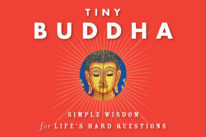
“I vow to let go of all worries and anxiety in order to be light and free.” ~Thich Nhat Hanh
I’ve struggled with anxiety throughout my life. A difficult childhood and my highly sensitive personality meant I grew into an anxious kid—there was just too much pain and emotional overwhelm for my young brain to handle.
My anxiety most often manifested as perfectionism and people pleasing, so from the outside everything seemed great. I excelled in school and I was a good kid who did as she was told. But there was a war inside me.
I felt broken, unable to navigate these huge feelings of fear and uncertainty on my own. Full of negativity and self-criticism, I felt like an outsider, misunderstood by the world, scared and alone.
Over the years, as I stuffed down these feelings of inadequacy and isolation, I internalized the belief that somehow I was not good enough, that there was something inherently wrong with me.
Afraid of being found out, ridiculed, and humiliated, I became invisible. I masked my fears, shame, and feeling rejected with arrogance. I became rigid and controlling. I was super hard on myself. I felt restless, angry, and defective even more.
In denial about all of this until my late thirties, my children finally cracked me open.
Motherhood was full of its own challenges, and my perfectionism shifted into high gear—the image of a wonderful, ever caring, ever patient mother was front and center. Hell bent on giving my children everything I was missing growing up, I put an enormous amount of pressure and responsibility on myself.
The stress was too high and I started breaking down. I began to unravel.
Anxiety happens in the presence of danger you can’t do anything about. Fear is a healthy and helpful response when you’re in an immediate danger. It alerts us and mobilizes us into action. But if you’re safe at home thinking about something that might happen or something that happened long time ago, you’re suffering needlessly.
Anxiety can show up in many ways and on many levels: physically, emotionally, and mentally. For me, it’s being negative and super critical of myself—my anxious voice telling me I’m messed up not good enough, inherently wrong.
I get easily stressed and overwhelmed. I become a perfectionist; I get restless, on edge. I’m unable to relax, sleep, focus. I’m so caught up in my head with worries that I’m not present, I’m not there for people who matter most. My chest is tight, my arms and legs tingly, headache and backache show up unannounced.
And then I reject how it feels, wanting it to do away—my resistance only making things worse. Fear feeds on itself. I feel broken, I feel shame, and so I disconnect from others. Depression kicks in. I get stuck.
3 Steps Toward Healing Anxiety
Anxiety is often embedded deep into the subconscious, especially if there is a history of childhood trauma or neglect. Past events and experiences are stored in the body. Thinking patterns and defense mechanisms become habitual, and we carry them throughout our adult life, unaware of their negative consequences. These are all hard things to deal with.
Fortunately, we have the capacity to change our brain by learning to be present, and becoming more aware of our habitual thoughts and behaviors. The brain is “plastic”; it can adopt new behaviors and learn new ways of looking at the world. This process is slow, but it’s our opening into healing anxiety.
Mindfulness is the foundation of change.
The first step in calming anxiety is mindfulness—becoming aware of the here and now, without judgment or trying to change our experience. The good news is that our physical body is a perfect vehicle for bringing ourselves into present awareness. And we start with out breath.
Anxiety moves us out of the present moment and into our habitual reacting to the perceived threat. It overwhelms our brain and blocks us from seeing things clearly, entangling us in ceaseless fears and worries.
We can’t heal what we don’t know. Mindfulness is the tool that can shed the light on our habitual thinking, feeling, behaving, and holding patterns—that is, where in the body we’re holding onto our fear and pain. Bringing these patterns to light allows us to break the cycle.
When you are triggered (someone says something critical to you, your child comes home from school crying, you argue with a friend or spouse), start by anchoring yourself in your breath.
Take a deep breath in, then slowly and fully exhale. Keep breathing deeply and slowly while allowing your experience to be as is, without judgment. This is truly hard—you may want to have a guided meditation handy for moments like this.
Slowly move your attention to your entire body and start tracking your sensations. This allows us to get out of our head and embody our current experience. We can begin to notice where in our body the fear and anxiety are being stored, where we might feel frozen, afraid, or on fire.
Observe, where is anxiety locked in your body? What does it feel like? What does it look like? What’s the texture, color, temperature?
A lot of tension from anxiety is stored around our eyes, jaw, neck. Notice this and consciously release the grip. Let those points relax.
If we’re able to stay present and open—with breath as our anchor—we will slowly calm the physical part of anxiety. This in turn, slows us down mentally, allowing us to calm down the racing thoughts and emotional reactions.
Observe your mind for a moment and notice any difference from when you began this meditation. Come back to your breath if you notice you’re drifting into your thoughts.
If you feel strong enough, you can notice and acknowledge any feelings and emotions you are now experiencing. You can commit to witnessing the fear, your vulnerability, allow and feel it so you can finally move past it.
Another helpful tactic is visualizing peace flowing into your body with each breath in, and tension leaving your body with each breath out. Breathe in calm, breathe our fear.
Again, if you’re feeling anchored, you can now observe your internal dialog in order to reframe your experience and learn new ways of responding in challenging situations.
You have to be willing to observe your negative thoughts and emotions with openness and clarity. You can then look at what triggered you and why? You can dissect your reactions to figure out better ways of responding next time. This way you learn new ways of coping and responding in the moments that push our sore spots.
Self-compassion is the engine that keeps us going.
Kristin Neff defines self-compassion as “being warm and understanding toward ourselves when we suffer, fail, or feel inadequate, rather than ignoring our pain or flagellating ourselves with self-criticism.”
No positive change can happen in the atmosphere of criticism and self-abuse. We can’t force ourselves to do better. We have to offer ourselves support and encouragement in order to heal and grow.
Negative self-talk is the hallmark of anxiety.
Perhaps, growing up, our caretakers criticized, shamed, or punished us for our mistakes and weaknesses and so we learned to treat ourselves this way. Perhaps we learned to believe that if we’re hard on ourselves, we’ll accomplish more, become a better version of ourselves.
Tune into that inner voice. What is it telling you? Does this voice remind you of someone from your past?
Tapping into self-compassion can help us break our entrenched patterns of self-criticism, while still allowing us to be honest about our fears.
We can remember that no one is perfect, and everyone struggles in one way or another. And we can offer ourselves kindness and understanding. We are not weak or defective. We are human, and all humans go through moments of struggle.
Think of your self-compassionate voice as a supportive and kind friend who’s encouraging you to see things in a clearer, more balanced way. Don’t add to the pain by putting yourself down, judging yourself harshly. Offer yourself understanding, love, and care. This is hard work, and you are doing the best you can with what you’ve got.
This is not about excusing your behavior or bathing yourself in self-pity. It’s about giving yourself love and support so you can do better, be stronger, so you can rise above your past pain and better handle struggles ahead.
Self-expression is the outlet for letting go.
The hardest part of anxiety is learning to let go. Letting go is difficult, even if consciously we understand that our hurt and fears are a heavy burden to carry. This is the stuff that weighs us down, physically and emotionally diminishing our life force.
The enormous energy needed to protect ourselves from pain and anxiety is depleting, and so we must learn to release the fears and unburden our soul.
As Della Hicks-Wilson tells us, we have to “let the truth exist somewhere other than inside your body.”
We have to get it out of our body, remove the stored pain, anxiety, fear, trauma, shock, and shame so we can make room for joy, peace and vitality.
One of the best forms of emotional release is by writing. When we write we give our internal world a voice. We slow down and clear our head, and gradually deepen our understanding of ourselves. We are then able to process and makes sense of what’s happening with us and around us. We gain a new perspective, discover new choices, develop new mindset.
Writing is an act of courage. You show up for yourself, expose your vulnerabilities bringing the ugly parts into the light to look at it up close. But the act of writing is liberating. It gives us permission to release.
By putting our fears and hurts down on paper, we can let them go without judgment or worry. Our journal becomes a safe space for us to free ourselves, get unstuck, move forward. When we write we release, and when we release we heal.
Healing Takes Time and Devotion
I still get anxious sometimes, as does everyone else, but over the years I’ve picked up strategies that allow me to cope and manage my anxiety so it doesn’t control my life. My most reliable tools are daily meditation, yoga, making art, journaling, spending time in nature, surrounding myself with people who love and support me, and being mindful of my internal dialog.
Writing has been the most transformative, however. When done mindfully, writing allows us to step back and shift our mindset, rewiring our brain over time. We can safely process our experience, integrate and heal it, all while staying present and kind to ourselves.
Slowing down is the key to successfully transforming anxiety, and both mindfulness and writing allow us to slow down the rollercoaster of reactions so we can unpack and integrate our experience.
We have a deep capacity to heal and grow, but we can only do with enough self-awareness, a healthy dose of self-compassion, and an empowering belief that we are inherently good.
About Joanna Ciolek
Joanna Ciolek is a self-taught artist, recovering self-critic, and the author of mindfulness-based prompt journals, The Art of Homecoming and The Art of Untangling. To learn mindfulness, reconnect with yourself, and begin your healing journey, join her Free Course at The Mindfulness Journal. Follow Joanna on Twitter, Instagram, and Facebook.
- Web |
- More Posts













 Though I run this site, it is not mine. It's ours. It's not about me. It's about us. Your stories and your wisdom are just as meaningful as mine.
Though I run this site, it is not mine. It's ours. It's not about me. It's about us. Your stories and your wisdom are just as meaningful as mine. 